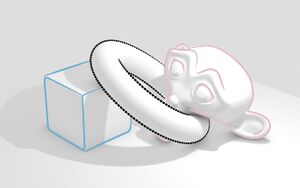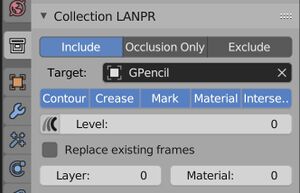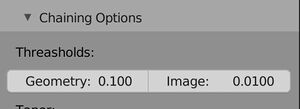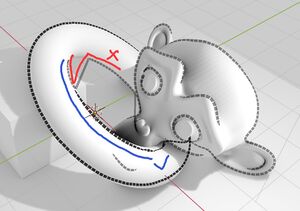User:Yiming/GSoC2019/Week5
Week 5 Report
This week
Major stuff
- Fixed LANPR now uses master "color" and "thickness" instead of following contour values.
- Done Stroke modifier now fully functional (includes target layer/material and line type selecting).
- Done Added LANPR settings for collection, now fully functional.
- Done Now you can set "Include/Exclude/OcclusionOnly" flags to objects and collections, to control what lines are needed. See below for how it works.
- Fixed LANPR now uses two separate threshold values for image-space and geometry space chaining. See below for explanation.
- Fixed Stroke sample modifier now re-written to accept bone weights in GPencil strokes. Which is also useful without LANPR.
- Temporary There's a "bake" button for baking frames in an animated scene into GPencil frames.
Minor Fixes
`if()` statements now all use`{}` brackets to prevent potential merge errors.- Comments all changed into
`/* */` style to follow C standard. - UI fixes, hide/deactivate items when needed to make it more logical to operate on.
From the Last Week
- Done Stroke generation from object modifier.
- Fixed Chaining occlusion errors.
- Fixed Chain now only includes one type of lines.
Next week
- Chain optimization functions, including:
- discard of very short segments
- small loop preventing
- overlapping reduction.
- GP Modifiers:
- pattern
- random
- backbone stretch improvements
- "sketch modifier"???
- see this document for a more clear idea what this is.
- LANPR and GPencil frame data should be automatically updated by Depsgraph.
- Better have a button that only re-create strokes for current object (by the Feature Line modifier). GP strokes are not deleted when LANPR is updating them, this could lead to overlapping.
About Object/Collection Usage Flag
This is how the usage flag works.
By default, Collection is set to "Include", which means this collection will be included into LANPR's feature line calculation. For object, the default is "Inherent", which means it follows its parent collection's settings.
If you set object's usage to "Occlusion Only", the object will still take part in LANPR's calculation, however, no lines will be produced by this object, but it can still occlude other object in the calculation. If the flag is "Exclude", LANPR will ignore this object completely, as if it didn't exist at all.
For collection, you can also set it to "Occlusion Only" and "Exclude", but if you only set the flag, the object within this collection who also happens to have a Feature Line modifier will still be included into calculation. To prevent this from happen, check the "force" option below. Then the children objects and those recursive children collections are all forced to follow the rule.
You need to set target GPencil object for strokes to appear, which applies to both objects and collections.
How to generate strokes: As of now, you need to manually click "Update" in LANPR, then click "Update" in any one of your Feature Line modifiers, and tab your GPencil object to trigger re-draw.
About Stroke Chaining in LANPR
LANPR produces accurate occlusion info, yet in 3D space, those lines might be very jaggy and not good for applying a texture. Thus we need a good chaining algorithm. Currently it performs ok, LANPR uses two step chaining method now, geometry-space and image-space chaining, they can produces smooth lines in most cases, yet some cases it's hard to say which way is better.
For bumpy surfaces, one might rely more on image-space chaining to erase those non-continuous bumps along a curve, however for many hard-surface scenarios, it is more important to keep the geometric information accurate. So now LANPR incorporates two threshold values for users to choose which way they want. Set thresholds to zero will disable the corresponding chaining step.
The image to the right shows a result of an image-space prioritized chaining. In which you can see the spatial result is incorrect, but it gives a smoother approximate in image space projection, which is useful in many cases, especially in rendering animated characters. Thus the two-threshold solution is necessary.
YimingWu





